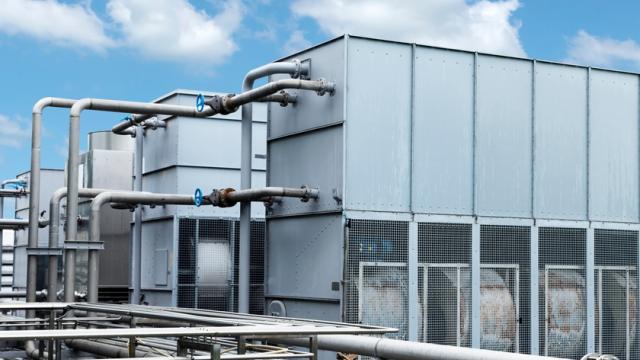Cooling towers are widely used in commercial and industrial facilities in chillers, air conditioning systems and process cooling equipment. They regulate temperature by removing heat from circulating water, primarily through evaporation. By design, cooling towers use a significant amount of water. Proper management of that water can increase cooling tower efficiency and life span, reducing your operating and maintenance costs.
Going with the Flow
Water leaves a cooling tower in four ways:
- Evaporation. This is the main function of the tower and the way heat is transferred from the circulating water to the environment.
- Blowdown. During evaporation, dissolved solids are left behind, causing scaling and corrosion. Draining off the water from the system controls the buildup of corrosion.
- Drift. A small quantity of water may be carried from the tower as mist or small droplets. Drift loss is small compared to evaporation and blowdown.
- Leaks and overflows. Leaks or overflow from the tower basin or structure can result in significant water loss.
Water losses from evaporation, blowdown, drift and leaks must be replaced by makeup water.
Reducing Water Demand
A key measure of cooling tower operation is cycles of concentration, the ratio of the dissolved solids in the blowdown water compared to the makeup water. Increasing cycles of concentration (prior to significant scale formation) will reduce blowdown as well as the demand for makeup water, improving overall water efficiency. The following measures can help increase cycles of concentration:
- Install a side-stream softening system to continuously remove solids from makeup water.
- Implement a comprehensive air handler coil cleaning and maintenance program. Dirty coils force the chilled water system to work harder to maintain the set temperature, increasing energy and water consumption.
- Consider alternative water treatment options, such as ozonation or ionization, electrochemical reactors, oxidation, ion exchange or polymer-based inhibitors to reduce water and chemical usage.
- Install covers to block sunlight penetration. Reducing the amount of sunlight on tower surfaces can significantly reduce biological growth, such as algae, as well as reduce evaporation.
- Upgrade to an automated chemical feed system for larger towers (100 tons or more). These systems reduce water use while controlling against scale corrosion.
- Use acid treatment, such as sulfuric or ascorbic acid, where appropriate. Acid can improve efficiency by controlling scale buildup. Proper management is essential to ensure safety and prevent damage to the system.
Water Reuse
You can improve cooling tower water efficiency by using alternative sources for makeup water. Examples include collecting condensation from air handlers and then pumping it back to the tower system makeup or implementing a reverse osmosis system for blowdown.
Condensed water collected from air handlers is a good source of high-quality makeup water because it's relatively pure and requires little additional treatment. These systems are typically simple to design and cost-effective to install.
Reverse osmosis (RO) is common in applications with high water purity requirements. The blowdown water is sent into an RO system, which purifies most of the water for reuse and concentrates the dissolved solids into a smaller waste stream. RO systems are complex and expensive to install and operate. They can be a cost-effective option in areas where water resources are limited or where discharge regulations restrict water blowdown.
Connections Newsletter for August 2023
From industry trends and best practices to sustainability initiatives, our monthly Connections Newsletter provides valuable insights, updates, and resources to support our large business customers.
Full Newsletter